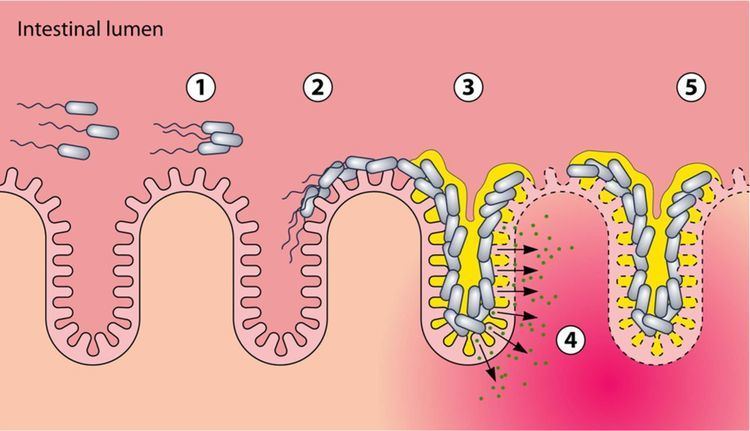Higher classification E. coli | Rank Subspecies | |
 | ||
Similar Escherichia, Bacteria, Enterobacteriaceae, Shigella flexneri, Yersinia enterocolitica | ||
Enteroaggregative Escherichia coli (EAEC, or EaggEC) are a pathotype of Escherichia coli associated with acute and chronic diarrhea in both the developed and developing world. EAEC are defined by their "stacked-brick" pattern of adhesion to the human laryngeal epithelial cell line HEp-2. The pathogenesis of EAEC involves the aggregation of and adherence of the bacteria to the intestinal mucosa, where they elaborate enterotoxins and cytotoxins that damage host cells and induce inflammation that results in diarrhea.
EAEC is now recognized as an emerging enteric pathogen. In particular, EAEC are reported as the second most common cause of traveler's diarrhea, second only to Enterotoxigenic E. coli, and a common cause of diarrhea amongst pediatric populations. It has also been associated with chronic infections in the latter, as well as in immunocompromised hosts, such as HIV-infected individuals. Awareness of EAEC was increased by a serious outbreak in Germany during 2011, causing over 5000 cases and at least 50 fatalities. The pathogen responsible was found to be an EAEC O104:H4 strain which was lysogenized by an a Shiga toxin encoding phage (typically associated with Shiga toxin-producing Escherichia coli, which often encode the adhesin intimin). The putative cause of the outbreak were sprouted fenugreek seeds.
Strains of EAEC are highly genetically heterogeneous, and the identification of virulence factors important for pathogenesis has proven difficult. Many EAEC encode a transcriptional factor named aggR (aggregative Regulator), part of the AraC family of transcription activators. AggR regulates many plasmid, as well chromosomally encoded, virulence factors, that include genes implicated in aggregative adherence fimbriae biogenesis and toxin production. Several toxins have been linked to EAEC virulence, including ShET1 (Shigella enterotoxin 1), Pet (plasmid‐encoded toxin), and EAST-1. However, further studies of these factors have failed to elucidate their role in pathogenesis.
More recently, a study of symptomatic children in Mali has led to increased interest in specific sets of EAEC virulence factors. The study utilized Classification and Regression Tree analysis, or CART analysis, to identify sets of EAEC factors which were implicated in virulence amongst pediatric patients who presented with acute diarrhea. The researchers found that a subset which encoded the gene for the cryptic serine protease SepA, previously described in Shigella, and lacking the transcriptional regulator of hemolysin expression, rmoA were associated with virulence. Furthermore, a set of EAEC which encoded the flagellar antigen H33 and the EAST-1 toxin were associated with diarrhea. These results and more recent efforts have suggested that a specific set of virulence determinants may be more important in pathogenesis of EAEC than the presence or absence of singular virulence factors.
